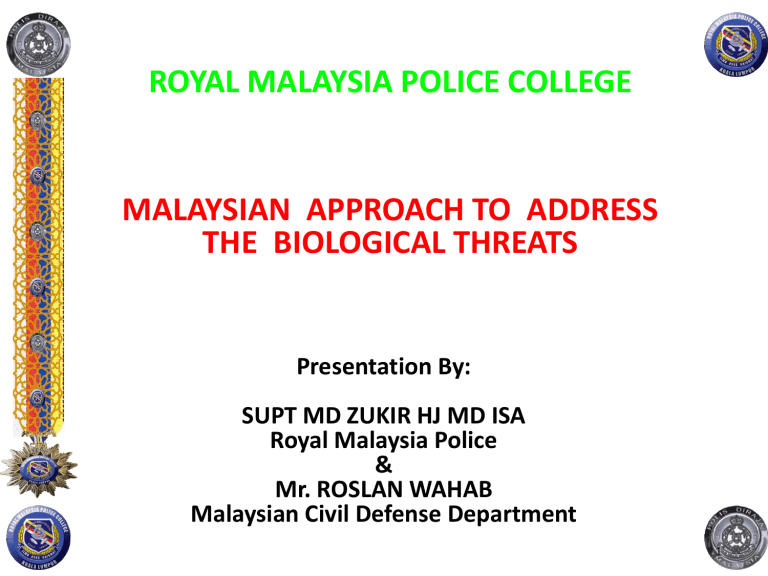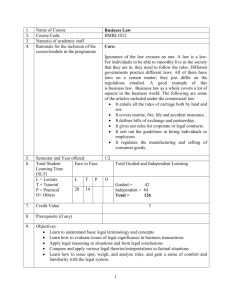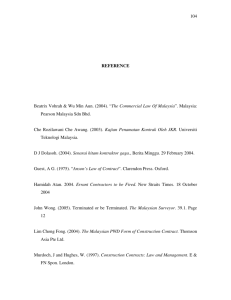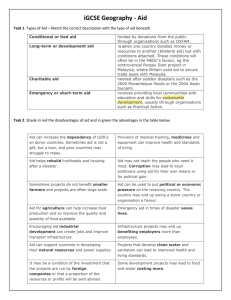MALAYSIA - ASEAN Regional Forum

ROYAL MALAYSIA POLICE COLLEGE
MALAYSIAN APPROACH TO ADDRESS
THE BIOLOGICAL THREATS
Presentation By:
SUPT MD ZUKIR HJ MD ISA
Royal Malaysia Police
&
Mr. ROSLAN WAHAB
Malaysian Civil Defense Department
1
SCOPE
• INTRODUCTION
• MALAYSIAN GOVERNMENT’S STAND ON
TERRORISM
• MALAYSIAN GOVT’S APPROACH TO CBRN THREAT
• EXECUTIVE POWERS, JURISDICTION AND ROLES OF
AGENCIES
• MALAYSIA’S EXPERIENCE WITH CBRN-CASES OF
ANTRAX SCARE
• CONCLUSION
2
INTRODUCTION
• The Malaysian government views the biological threats seriously
• Recognize that biological attack threatens the security of the entire nation
• Malaysia as a whole, needs to be well prepared for such eventuality and no effort is spared in preparing to meet and overcome such challenges
3
MALAYSIAN GOVT’S STAND ON TERRORISM
• Condemns and opposes any form of terrorism;
• Giving due regards to the protection of lives of hostages and property;
• Resolving crisis/conflict through negotiation;
• Opposes exchange of hostages as a solution; and
• Taking armed assault action as the last option.
4
MALAYSIAN GOVT’S APPROACH TO CBRN THREAT
Malaysia has adopted a holistic approach with the following comprehensive framework namely:
• A clear authoritative guideline as to the executive powers and jurisdiction as well as roles and functions of each of the agency or Ministry in managing a crisis, both terrorism or terrorist related disaster.
• A corpus of effective legislations to enforce or execute the plan;
• An efficient law enforcement and monitoring agencies; and
• International cooperation at the bilateral, multilateral, regional or inter regional levels
5
EXECUTIVE POWERS, JURISDICTION AND
ROLES OF AGENCIES
• In Malaysia, the policy making body and authority that decides on the mechanism to manage and coordinate any disaster or terrorism related disaster is the National Security Council (NSC) under the
Prime Minister’s Department .
• Under this body (NSC) each agency involved in disaster handling will be able to execute its duties in a more orderly and coordinated manner avoiding confusion, conflicts, contradictory or duplication of roles in the management of a disaster.
6
• The National Security Council Directive No 18:
Definition which include the use of lethal weapons, explosives, hazardous material or destruction i.e. CBRN.
weapon of mass
Specifically provides the managing mechanism.
Defines the role and functions of each agency.
Among the agencies are Royal Malaysia Police
(RMP), The Ministry of Health, Fire and Rescue
Department, Civil Defense Department etc
RMP is the lead agency in crisis and disaster management of the country. Other gencies/ departments would act as the supporting agency in accordance to their expertise.
7
Roles of the Ministry of Health (MoH) in managing biological threats :
• MoH has set up a multidisciplinary team to establish a national outbreak preparedness plan to meet any eventualities as a result of infectious diseases outbreaks, including bio terrorist attacks.
• The plan involves the setting up of rapid response teams at district, state and national levels. This team is a predetermined team identified based on individual expertise and experience and assembled by matching expertise and incident needs in order to provide rapid response to manage such outbreaks effectively.
8
• The surveillance of infectious diseases( laboratory- based surveillance and a syndromic surveillance) is the responsibility of the Surveillance Unit of the Disease Control
Division, MoH which also monitors unusual outbreaks occurring in any part of the world.
• Risk Communication: Sharing medical Intelligence on biological threats with International Agencies such as The
Center of Disease Control , Atlanta and The Secretariat of
WHO.
• Providing early information to the public as well as the media.
9
• Effective Legislations:
Preventive laws i.e. Internal Security Act ( ISA )
1960
Principal laws i.e. Penal Code and Criminal
Procedure Code were amended in 2003 to decree the commission of terrorist acts, the financing of terrorism and hostage taking. The law provides death punishment for acts of terrorism and offences as seizable and non- bailable.
10
- Other relevant legislations
- The Anti Money Laundering Act 2001;
- The Mutual Assistance In Criminal Matters Act
2002; and
- The Chemical Weapons Convention Act 2004.
• An Efficient Law Enforcement Agency (RMP)
- RMP is the lead agency in the enforcement of criminal and security offences which includes terrorist related incident.
- Trained locally and abroad on threats of WMD and counter terrorism. RMP’s forensic lab is capable to analyze both bio and chemical samples in consort with the Chemistry
Department and the MoH.
11
International Cooperation
- Malaysia is currently a State Party to 9 of the 13 (2007)
International Conventions and Protocols on
CombatingTerrorism.
14 May 2002 – Malaysia and the US signed a
Declaration on Co-operation to combat terrorism. Framework of cooperation include prevention, disruption and combating international terrorism.
- August 2002 - MoU on similar co-operation signed with the Australian Government,
- Co-operation through ASEANAPOL. Provides mutual assistance and reciprocity in prosecutions, tracing, interviewing of witnesses and suspects, as well as procurement of information and criminal records.
12
MALAYSIA’S EXPERIENCE WITH CBRN-CASES OF
ANTRAX SCARE
• Throughout October 2001, 89 incidents of anthrax scare were reported to the Malaysian Police and 6 incidents in November 2001. Total 95 cases were reported;
• No arrest were made arising from these reports;
• Laboratory tests by the Institute of Veterinary
Research Malaysia (IVR) confirmed that they were negative;
• The work of pranksters who wanted to create panic.
13
CONCLUSION
• The scourge of terrorism and the biological threats could only be managed and overcome through a concerted effort and cooperation among member countries.
• Malaysia welcome such an effort to achieve the objective of this workshop for a more peaceful and a better world for all
14






